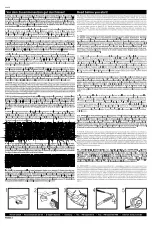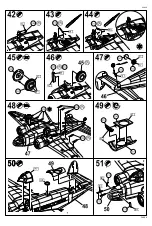
®
Hudson Mk. I / II
Patrol
Bomber
04838-0389
©
2013 BY REVELL GmbH. A subsidiary of Hobbico, Inc.
PRINTED IN GERMANY
Hudson Mk. I / II Patrol Bomber
Hudson Mk. I / II Patrol Bomber
Die Lockheed Hudson basierte auf dem Model Nr.14, einem
zivilen Verkehrsflugzeug, und wurde vor Ausbruch des
Zweiten Weltkriegs zunächst als Navigationstrainer für die
Royal Air Force entworfen. Die British Purchasing Commission
(Beschaffungskommission) begutachtete im April 1938 den
Vorschlag von Lockheed in Burbank, Kalifornien. Sie entschied
dann aber, dass das Flugzeug für Seepatrouilleneinsätze besser
geeignet wäre. Die kleine Firma Lockheed verpflichtete sich zu
einer Lieferung von 250 Stück der neuen Variante bis Ende
1939 und erfüllte den Auftrag sogar fast zwei Monate vor
dem vereinbarten Zeitpunkt. Die erste RAF-Squadron, die
Maschinen des Typs Hudson Mk.1 erhielt, war im Mai 1939 die
No. 224 in Leuchars/Schottland. Dort ersetzte die Hudson die
Avron Anson. Auf insgesamt 350 Flugzeuge der Version Mk.I
folgten 20 Stück Mk.II; die beiden Versionen waren identisch,
aber bei der Mk.II wurden Senknieten verwendet, die einen
leichten Leistungsvorteil brachten. Diese ersten Flugzeuge hat-
ten Vorkehrungen für optionale Maschinengewehrstationen
sowohl auf dem Rücken als auch der Bauchseite der Flugzeug -
zelle, die bei den späteren Versionen dann standardmäßig ein-
gebaut wurden. Insgesamt wurden 2.941 Flugzeuge des Typs
Hudson gebaut, von denen die meisten bei der RAF Coastal
Command eingesetzt waren. Mit den Wright Cyclone GR-
1820-Motoren konnte eine Höchstgeschwindigkeit von 396
km/h (246 mph) auf 1.981m Höhe (6.500ft) erreicht werden.
Die Reichweite betrug 3.476 km (2.160m). Spannweite: 19,96m
(65ft 6in.), Länge: 13,51m (44ft 4in.).
The Lockheed Hudson, based on the Model 14 civil airliner, was
originally conceived as a navigation trainer for the Royal Air
Force before the outbreak of World War Two. The British
Purchasing Commission viewed Lockheed’s proposal in April
1938 at Burbank, California and decided the aircraft would be
better suited to maritime patrol missions. The small Lockheed
company agreed to supply 250 of the new aircraft before the
end of 1939, which they achieved nearly 2 months ahead of
schedule. The first RAF squadron to be equipped with the
Hudson Mk.I was No.224 at Leuchars, Scotland in May 1939
where they replaced Avro Ansons. A total of 350 Mk.I’s were
followed by 20 Mk.II’s which were identical except that the
new version had flush rivets which gave a slight improvement
in performance. These first aircraft had provision for optional
beam and ventral machine gun positions and these were fitted
as standard on subsequent models. Total Hudson production
was 2941, most serving with RAF Coastal Command. The
Wright Cyclone GR-1820 engines gave a maximum speed of
396km/h (246mph) at 1,981m (6,500ft). Range was 3476km
(2160 miles). Wingspan: 19.96m (65ft 6in.) Length: 13.51m (44ft
4in.)
Summary of Contents for Hudson Mk. I/II Patrol Bomber
Page 2: ...04838 ...
Page 5: ...22 23 04838 PAGE 5 ...
Page 6: ...04838 PAGE 6 ...
Page 7: ...04838 PAGE 7 1 1 ...
Page 8: ...04838 PAGE 8 1 1 2 2 ...
Page 9: ...04838 PAGE 9 ...
Page 10: ...04838 PAGE 10 ...






























